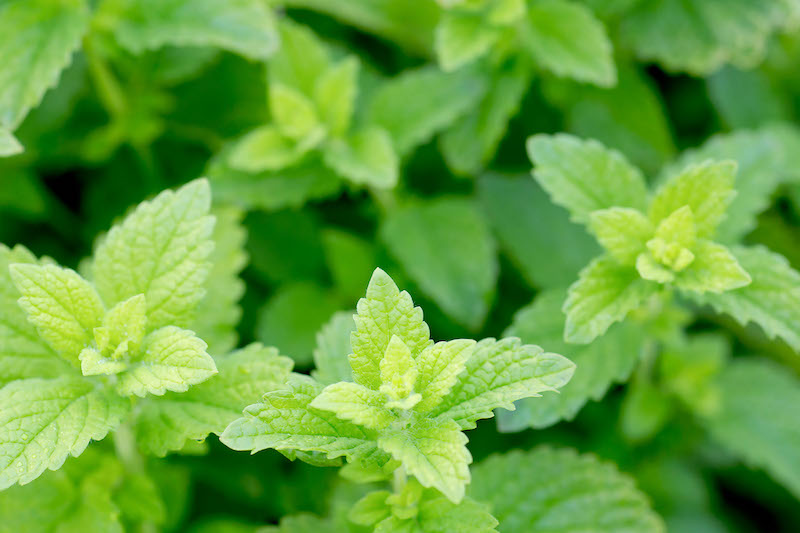You are about to leave the Herb Pharm website. The website will open in a new browser window.
Please select "OK" to continue to the website, or close this box to return to Herb-Pharm.com.

Melissa officinalis
Plant Family
Lamiaceae – Mint family
Other Names
Balm, Bee Balm, Melissa, Melissa Balm1
Parts Used
herb
Uses
Calming support for the nervous system.*
Prominent Phytochemicals
Prominent Constituents as Reported in Scientific Literature: Volatile oils, flavonoids, tannins, phenolic acids, monoterpene glycosides and acidic triterpenes.2,3,5
Lemon Balm is a great companion plant for brassicas (like Broccoli, Cauliflower and Cabbage) in the garden.6
Description
Lemon Balm is an aromatic monoecious herbaceous perennial that grows approximately one to two feet in height.3,4,5 Leaves are opposite in position, hairy and heart or ovately shaped with a toothed or crenate margin.3,4,5 Stems are characteristic of the Lamiaceae family — square-shaped, hairy and branched.3,5 Flowers are white to yellow to pinkish in color and arise from the leaf axils.3,4,5 They are small and tubular with two lips, and the lower lip has three lobes.3,9 Seeds are dry, smooth nutlets.9
Origins & History
Lemon Balm is native to what is now Turkey and the Eastern Mediterranean.3 The plant has been introduced in Canada and North America.8
Cultivation occurs commercially all over but specifically in North America and central, eastern and southwestern Europe.3 Cultivation occurs easily in spring or autumn by cuttings, seeds or root division.4 The plant is commonly grown in home gardens for use in herbalism or landscaping.6 Lemon Balm prefers a habitat of neglected land and waste areas near residences, including woodland gardens, dappled shade or shady edges.6 Soil and sun preferences include sandy or loamy soil, well-drained dry to moist soils and part sun to part shade.6
It is hardy in USDA zones 4 through 8 and is drought tolerant once established.6 Lemon Balm can live in challenging arid soil locations where others fail.6 The flowers have a long blooming season from June to October, while the seeds mature from August to October.4,6 The plant self-seeds itself readily, becoming a nuisance to some.6 By cutting the plant back hard after it flowers, it will yield a second harvest.6 Lemon Balm is a great companion plant for brassicas in the garden.6 Deer and rabbits are not interested in this plant, further making it a great addition for any garden.6
Lemon Balm is widely used in Europe, where it’s often associated with honey, because it is pollinated by bees.3,4,6 Its botanical genus name, Melissa, comes from mel, the Latin translation for “honey.”4 Mélissa is also the Greek translation for “bee.”3,4 John Gerard, the botanist, and Pliny the Elder, the naturalist, noted that Lemon Balm was often planted near beehives and the leaves rubbed on the hives to keep the insects together, attract more bees and make sure they could find their way home.4 The plant’s common name, Balm, is said to be abbreviated from Balsam, due to its honeyed volatile essential oil content.4
Because of its strong and long-lasting scent, Lemon Balm is often dried and used in potpourri.4 In olden times, the essential oil was distilled and commonly combined with Lemon essential oil in the perfume industry.4 Lemon Balm essential oil is now used in aromatherapy.6
Native American cultures, specifically Cherokee and Costanoan tribes, have used Lemon Balm in herbalism.7
Paracelsus, a 16th century alchemist and physician, believed Lemon Balm could “completely revivify a man.”4 Lemon Balm was the main ingredient of a 14th century herbal spirit called “Carmelite water” that also contained Angelica, Lemon peel and Nutmeg.4 It was created by the nuns of Abbey of St. Just, and was said to support the nervous system.*4
References
Don't forget! Check your Rewards account for coupons.
CHECKOUT
You are about to leave the Herb Pharm website. The website will open in a new browser window.
Please select "OK" to continue to the website, or close this box to return to Herb-Pharm.com.